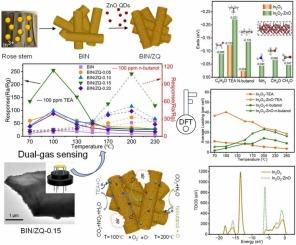ZnO量子点敏化生物模板In2O3微管用于低温选择性检测三乙胺和正丁醇
IF 3.7
1区 化学
Q1 CHEMISTRY, ANALYTICAL
引用次数: 0
摘要
双选择气体传感器是开发高性能、小型化和低成本传感设备的理想选择。在此,我们报道了一种基于ZnO量子点(ZnO QD)敏化生物模板In2O3微管(BIN)的仿生双选择性气体传感器,用于低温选择性检测正丁醇和三乙胺(TEA)。以废弃玫瑰茎为生态友好型生物模板,采用快速浸渍和煅烧法制备了BIN,并在其上对溶胶-凝胶法制备的ZnO量子点进行修饰,得到了层次化多孔复合材料(BIN/ZQ)。添加15% ZnO量子点(BIN/ZQ-0.15)的复合材料的传感性能得到了显著改善,在100℃条件下,其响应值分别为254 ~ 100 ppm TEA和108 ~ 100 ppm正丁醇,在200℃条件下,其检测限为十亿分之一(ppb),具有良好的双选择性和稳定性。通过对复合传感器对TEA和正丁醇混合气体的传感行为研究,证明了复合传感器能够检测出混合气体中单个气体的浓度。密度泛函理论(DFT)计算表明,增强的传感性能归因于In2O3/ZnO异质结的协同效应、丰富的氧空位、分层多孔结构以及TEA和正丁醇分子在复合材料表面的优先吸附。首次采用分子动力学与DFT模拟相结合的方法研究了复合材料在不同温度下双选择性的原因。这项工作将启发设计具有双选择性、低工作温度和低成本制造的气体传感器的策略。本文章由计算机程序翻译,如有差异,请以英文原文为准。

ZnO QDs sensitized bio-templated In2O3 microtubes for low temperature dependent selective detection of triethylamine and N-butanol
Dual-selective gas sensors are highly desirable for developing high-performance, miniaturized, and low-cost sensing devices. Herein, we report a bio-inspired dual-selective gas sensor based on ZnO quantum dot (ZnO QD)-sensitized bio-templated In2O3 microtubes (BIN) for low-temperature selective detection of n-butanol and triethylamine (TEA). BIN were synthesized by a facile impregnation and calcination process using waste rose stems as eco-friendly bio-templates, and sol-gel synthesized ZnO QDs were modified on it to obtain the hierarchical porous composites (BIN/ZQ). The composite with 15 wt% ZnO QDs (BIN/ZQ-0.15) exhibited significantly improved sensing properties, and it achieved high response values of 254 to 100 ppm TEA at 100℃ and 108 to 100 ppm n-butanol at 200℃, respectively, demonstrating a dual selectivity with their parts-per-billion (ppb) detection limits and good stability. The study on sensing behavior of the composite sensor to mixed TEA and n-butanol gas proved its ability to detect the concentration of individual gases in their mixture. The enhanced sensing performance was attributed to the synergistic effects of the In2O3/ZnO heterojunctions, abundant oxygen vacancies, hierarchical porous structure, combined with the preferential adsorption of TEA and n-butanol molecules on the composite surface, as revealed by density functional theory (DFT) calculations. Molecular dynamics combined with DFT simulations were further employed to study the reason for the dual selectivity of the composite at different temperatures for the first time. This work would inspire strategies for designing gas sensors with dual selectivity, low operational temperatures, and cost-effective fabrication.
求助全文
通过发布文献求助,成功后即可免费获取论文全文。
去求助
来源期刊

Sensors and Actuators B: Chemical
工程技术-电化学
CiteScore
14.60
自引率
11.90%
发文量
1776
审稿时长
3.2 months
期刊介绍:
Sensors & Actuators, B: Chemical is an international journal focused on the research and development of chemical transducers. It covers chemical sensors and biosensors, chemical actuators, and analytical microsystems. The journal is interdisciplinary, aiming to publish original works showcasing substantial advancements beyond the current state of the art in these fields, with practical applicability to solving meaningful analytical problems. Review articles are accepted by invitation from an Editor of the journal.
 求助内容:
求助内容: 应助结果提醒方式:
应助结果提醒方式:


